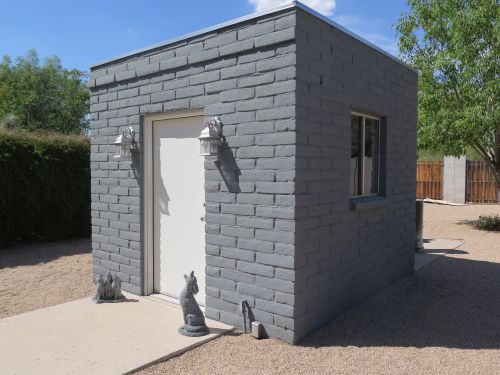When Sheds A-Tack

I have a shed; a right fine shed--
Designed, alas, for tack.
Its shelves collapsed beneath my stuff
As strength is what they lack.
There is an equestrian or two among my readers who will know what a "tack shed" is; for everybody else, some history is in order: When our neighborhood was platted out of ranchland in the mid-1960s, the lots were made deliberately large (1/2 acre to 1 acre) because having a horse behind your suburban ranch house was trendy in that era. Most of the horse setups are gone now (though the folks at the end of our block still have theirs, and in fact still have a horse) but what generally remain are the tack sheds, which are small, study buildings that house horse equipment like saddles, blankets, bridles, and (probably) shovels.
Our tack shed was gutted and rehabbed (probably) when the house itself was rebuilt in 2003. Or maybe the shelves were original. I have no way to tell. But when we moved in over the year starting mid-December 2015, I piled all the stuff onto those shelves that wouldn't fit anywhere else. This included boxes full of gears and bearing blocks, stepper motors, box fans, variable capacitors, casters, Popular Electronics, heat sinks, great big electrolytic caps, chassis boxes, and odd lots of every species within the phylum that contains a lot of metal and/or coated paper.
All was well until earlier this year, when I noticed that the shelves were cracking and buckling under the load. I did some propping with scrap dimensional lumber, but it was obvious that tack shelves (if that's what they were) will not hold that much metal and that many boxed vintage AM rigs. The propping did us through the summer, but with cooler mornings coming in I set out to put it all right. Mostly, that meant emptying the shelves, tearing out the shelves, and putting in Home Depot Husky steel shelf units.
So this morning I went out to the garage to get the handcart and kick off the festivities. Hmmm. The cart hadn't been used for probably eighteen months, and both of its pneumatic tires were flat. So I loaded it into the Durango and ran up 64th Street to the Shell station and its $1.50 air machine. One tire filled without trouble. The other had pulled enough away from its rim so that it didn't have a good seal (or any seal at all, actually) and as fast as I squirted air in, the air gleefully escaped. Worse, the tire had deformed slightly and was no longer completely round.
I am the son of an engineer, and drew it all out in my head: I had to apply pressure to the center periphery of the tire to get its sidewalls to expand against the rim. First I tried bungee cords, of which I keep many in one of the wells in the cago hold. Alas, the tire was pathologically the wrong size to wrap a bungee around it and hook the two ends together with the tire under pressure. So I drove home and did it again with rope. When I went back to Shell, the tire gripped the rim and pressurized without additional mayhem, though I had to feed the air machine another buck and a half in quarters.

Some lessons here: Always store carts with pneumatic tires so that there is no pressure on the tires. None; not even the weight of the cart. Also, keep rope in your car and quarters in your pocket. Murphy's out there somewhere, watching...
I managed to get all the junk out of the shed and stacked on the patio. Then I began tearing out the shelves, but by noon it had gotten hot enough that I bailed for the day, after a short bypass through the pool. I'll get back to it tomorrow morning, and with any luck at all finish the demo portion of the project.
Once the Husky shelves are safely in place (I drew the shelves and the building in Visio to make sure it would all fit) I will begin asking myself how many cartons of chassis boxes will I likely consume over the remaining 20-30 years of my life. Maybe I should take some to a hamfest, though that will mean finding a hamfest. Do I really need a Sixer and a Twoer? Do any of the gears in the box actually mesh? What's in the two or three boxes with no markings at all?
A retiree's work is never done.